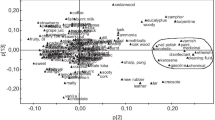Abstract
The smell of a molecule is subjective, because there is a variablity in its representative language. The reporting is done according to the vocabulary repertoire of human subjects and researchers concerned. The olfactory databases thus consist of molecules and their smell characteristics defined by words. In this paper, we have demonstrated a network based approach based on the words to understand the perceptual universe. We defined perceptual communities based on the normalized co-occurrence network and hence propose the perceptual classes. We find the characteristics of this perceptual social network. We have also proposed a generative LDA-based topic modeling approach for topic detection in olfactory databases. This is for the first time that an objective approach to defining perceptual classes has been carried out which confirms with many subjective analyses that has been done till now. This work may open new avenues towards understanding the relationship between language and olfaction besides objectively defining perceptual classes.
Access this chapter
Tax calculation will be finalised at checkout
Purchases are for personal use only
Preview
Unable to display preview. Download preview PDF.
Similar content being viewed by others
References
Ahn, Y.-Y., Ahnert, S.E., Bagrow, J.P., Barabási, A.-L.: Flavor network and the principles of food pairing. Sci. Rep. 1 (2011)
De Smet, W., Moens, M.-F.: Cross-language linking of news stories on the web using interlingual topic modelling. In: Proceedings of the 2nd ACM workshop on Social web search and mining, pp. 57–64. ACM (2009)
Hong, L., Ahmed, A., Gurumurthy, S., Smola, A.J., Tsioutsiouliklis, K.: Discovering geographical topics in the twitter stream. In: Proceedings of the 21st International Conference on World Wide Web, pp. 769–778. ACM (2012)
Purver, M., Griffiths, T.L., Körding, K.P., Tenenbaum, J.B.: Unsupervised topic modelling for multi-party spoken discourse. In: Proceedings of the 21st International Conference on Computational Linguistics and the 44th Annual Meeting of the Association for Computational Linguistics, pp. 17–24. Association for Computational Linguistics (2006)
Steyvers, M., Griffiths, T.: Probabilistic topic models. Handb. latent Semant. Anal. 427, 424–440 (2007)
Chang, J., Gerrish, S., Wang, C., Boyd-graber, J.L., Blei, D.M.: Reading tea leaves: how humans interpret topic models. In: Advances in Neural Information Processing Systems, pp. 288–296 (2009)
Wang, W., Barnaghi, P., Bargiela, A.: Probabilistic topic models for learning terminological ontologies. Knowl. Data Eng. IEEE Trans. 22, 1028–1040 (2010)
Shmulevich, I., Dougherty, E.R., Zhang, W.: From Boolean to probabilistic Boolean networks as models of genetic regulatory networks. Proc. IEEE 90, 1778–1792 (2002)
Auffarth, B.: Understanding smell—The olfactory stimulus problem. Neurosci. Biobehav. Rev. 37, 1667–1679 (2013)
Khan, R.M., et al.: Predicting odor pleasantness from odorant structure: pleasantness as a reflection of the physical world. J. Neurosci. 27, 10015–10023 (2007)
Zarzo, M., Stanton, D.T.: Identification of latent variables in a semantic odor profile database using principal component analysis. Chem. Senses 31, 713–724 (2006)
Gottfried, J.A., Dolan, R.J.: The nose smells what the eye sees: crossmodal visual facilitation of human olfactory perception. Neuron 39, 375–386 (2003)
Dunkel, M., et al.: SuperScent—a database of flavors and scents. Nucleic Acids Res. 37, D291–D294 (2009)
Leon, M., Johnson, B.: Glomerular response archive. (2008). http://gara.bio.uci.edu/index.jsp
Acree, T., Arn, H.: Flavornet (2004). http://www.flavornet.org/flavornet.html
Luebke, W.: The good scents company (1980). http://www.thegoodscentscompany.com/index.html
Molecular descriptors for chemoinformatics, 2nd edn. Wiley-VCH (2009) (3).pdf
Shaoul, C., Westbury, C.: Word frequency effects in high-dimensional co-occurrence models: A new approach. Behav. Res. Methods 38, 190–195 (2006)
Blondel, V.D., Guillaume, J.-L., Lambiotte, R., Lefebvre, E.: Fast unfolding of communities in large networks. J. Stat. Mech. Theory Exp. 2008, P10008 (2008)
Erdos, P., Rényi, A.: On the evolution of random graphs. Bull. Inst. Internat. Stat. 38, 343–347 (1961)
Abe, H., Kanaya, S., Komukai, T., Takahashi, Y., Sasaki, S.: Systemization of semantic descriptions of odors. Anal. Chim. Acta 239, 73–85 (1990)
Müller, J.: The H&R book of perfume: Understanding fragrance; origins, history, development; guide to fragrance ingredients. Glöss Verlag, Hambg (1992)
Zarzo, M.: Hedonic judgments of chemical compounds are correlated with molecular size. Sensors (Basel) 11, 3667–3686 (2011)
Řehůřek, R., Sojka, P.: Software framework for topic modelling with large corpora (2010)
Arun, R., Suresh, V., Madhavan, C.E.V., Murthy, M.N.N.: In: Advances in Knowledge Discovery and Data Mining, pp. 391–402. Springer (2010)
Author information
Authors and Affiliations
Corresponding author
Editor information
Editors and Affiliations
Rights and permissions
Copyright information
© 2015 Springer-Verlag Berlin Heidelberg
About this paper
Cite this paper
Kumar, R., Kaur, R., Bhondekar, A.P. (2015). The Smell Network. In: Wang, L., Uesugi, S., Ting, IH., Okuhara, K., Wang, K. (eds) Multidisciplinary Social Networks Research. MISNC 2015. Communications in Computer and Information Science, vol 540. Springer, Berlin, Heidelberg. https://doi.org/10.1007/978-3-662-48319-0_38
Download citation
DOI: https://doi.org/10.1007/978-3-662-48319-0_38
Published:
Publisher Name: Springer, Berlin, Heidelberg
Print ISBN: 978-3-662-48318-3
Online ISBN: 978-3-662-48319-0
eBook Packages: Computer ScienceComputer Science (R0)




